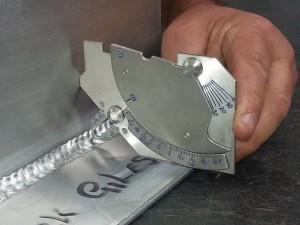How Welding Examination Contributes to Long Life and Integrity in Construction Projects
Welding inspection acts as a fundamental aspect in guaranteeing the longevity and integrity of construction tasks. By methodically identifying prospective flaws during numerous stages of manufacturing, welding inspections not just protect against costly failings however also promote a culture of top quality assurance within the group. Utilizing advanced strategies, such as non-destructive testing, promotes detailed evaluations while maintaining material honesty. As projects advance, the impact of these assessments becomes increasingly noticeable, increasing crucial inquiries about their long-lasting advantages and implications for general task success. What particular techniques can be implemented to make the most of these benefits?

Value of Welding Examination
Ensuring quality through welding evaluation is a vital component of any kind of manufacture task. It works as a guard to validate that welding processes meet well established requirements and specifications, therefore improving the general stability of the structure or element being produced. Welding inspection is not merely a step-by-step action; it is an important technique that assists identify potential problems early, ensuring that they are dealt with prior to they intensify right into significant issues.
The importance of welding assessment can be underscored by its function in maintaining safety and durability. Welded joints are commonly subjected to extreme conditions, and any problems can jeopardize the efficiency and long life of the final product. By applying extensive examination procedures, organizations can ensure compliance with sector regulations, thereby minimizing dangers related to architectural failings.
Furthermore, reliable welding evaluation fosters self-confidence amongst stakeholders, including clients and regulative bodies, that the task meets the best criteria. This not just boosts the reputation of the producer yet also adds to long-term expense savings by preventing rework and possible liabilities. Inevitably, welding assessment is essential to the success and dependability of manufacture tasks, strengthening the value of quality control in engineering practices.

Common Welding Defects
Welding problems can substantially weaken the structural stability of made elements, making their identification and rectification critical. Usual welding problems can be broadly categorized into three types: geometric, metallurgical, and service-related.
Geometric problems include concerns such as undercutting, where the base metal is eroded at the side of the weld, and excessive convexity, which can lead to tension concentration points. These flaws can jeopardize the strength and toughness of the weld joint.
Metallurgical defects occur from improper welding procedures or materials, resulting in problems such as porosity, where gas pockets develop within the weld, and lack of blend, which occurs when the weld steel stops working to bond appropriately with the base steel. These issues can dramatically deteriorate the weld's efficiency.
Service-related problems may not emerge until after the component is in usage. Instances include cracking because of thermal stress or exhaustion, which can cause devastating failures otherwise resolved.
Comprehending these common issues equips fabricators to apply efficient assessment strategies that enhance the reliability and long life of their jobs, eventually ensuring security and efficiency requirements are met.
Inspection Techniques and methods
A comprehensive approach to evaluation methods and techniques is necessary for recognizing and reducing welding flaws in manufacture projects. Various methods are utilized to make sure the stability of welds, including aesthetic examination, ultrasonic screening (UT), radiographic screening (RT), magnetic particle screening (MT), and color penetrant screening (PT) Each strategy has its toughness and certain applications.

Magnetic bit screening is useful for discovering surface and near-surface issues in ferromagnetic materials. By applying an electromagnetic field and utilizing ferrous fragments, inspectors can determine interruptions efficiently. Last but not least, dye penetrant testing highlights surface-breaking flaws via the application of a color that seeps right into fractures, making them noticeable under ultraviolet light.
Utilizing a mix of these approaches makes sure a rigorous evaluation, enhancing the dependability of welded structures.

Effect on Project Long Life
Effective assessment methods dramatically influence the longevity of fabrication projects. By determining possible flaws and variances in welding processes, assessments make certain that structures are built to endure functional stresses in time. When welds are thoroughly examined, the chance of undiscovered problems, which could bring about architectural failures, is decreased.
Normal assessments help with adherence to industry requirements and policies, which are critical for ensuring the sturdiness of bonded joints. Such conformity not only enhances the stability of the project however also guarantees stakeholders concerning the top quality of the work. Prompt discovery of flaws allows for restorative activities to be taken early, preventing pricey repairs or full overhauls down the line. Welding Inspection Milwaukee.
In addition, efficient examination techniques promote a society of top quality assurance within construction teams. They are much more most likely to stick to finest practices and maintain high criteria throughout the production procedure when employees are conscious that their work look at here now will be rigorously evaluated. Eventually, this dedication to top quality not only prolongs the life expectancy of the job yet likewise reduces maintenance prices, thus boosting the general financial feasibility of manufacture endeavors.
Enhancing Integrity in Construction
Integrity in construction is considerably improved via extensive examination processes that attend to prospective weaknesses in welding practices. Reliable welding inspection not just determines problems early yet additionally supplies critical comments to welders, making certain adherence to developed requirements and specifications. By using non-destructive testing methods, such as ultrasonic or radiographic evaluations, fabricators can determine the honesty of welds without jeopardizing the product.
Furthermore, normal inspections cultivate a culture of high quality and responsibility amongst fabrication teams. They are extra likely to adhere to ideal protocols and practices when welders recognize that their work is subject to strict analyses. This positive technique minimizes the danger of costly failings throughout the operational stage of a job.
Additionally, thorough documentation of examination results produces a beneficial database of information that can be used for future jobs. Trends in problems can be assessed to enhance welding strategies and training programs (Welding Inspection Milwaukee). Ultimately, enhancing integrity in manufacture through thorough evaluation processes not only enhances the life-span of the made elements but likewise reinforces stakeholder self-confidence in the task's total high quality and longevity. Buying durable welding inspection practices is crucial for achieving long-term integrity in any type of fabrication endeavor.
Final Thought
In summary, welding inspection acts as an important element in making certain the long life and dependability of construction projects. By determining issues early and using non-destructive testing techniques, inspections promote a culture of quality control that complies with industry criteria. The systematic documents of outcomes not only facilitates pattern analysis however also enhances liability and architectural honesty. Ultimately, effective welding evaluation techniques enhance stakeholder self-confidence and substantially add to the economic viability of fabrication ventures.
Welding inspection serves as a fundamental component in guaranteeing the longevity and integrity of manufacture jobs.Making certain top quality through welding assessment is an important element of any type of construction job. Ultimately, welding inspection is essential to the success and integrity of construction tasks, enhancing the value of top quality assurance in engineering practices.
A thorough method to assessment methods and techniques is crucial for alleviating and identifying welding flaws in construction projects.In recap, welding inspection offers as an important element in making sure the durability and reliability of fabrication jobs.